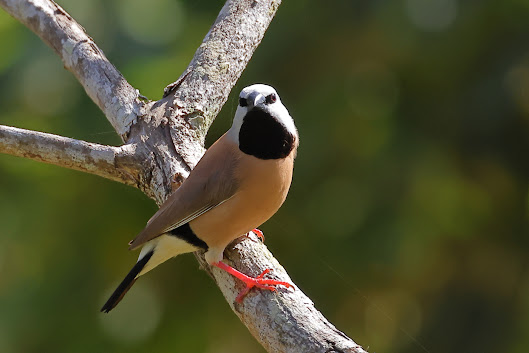 Rufous Night-Heron
Rufous Night-HeronMonday, June 29, 2009
Thursday, June 25, 2009
They're asking, where's the meat?
Friday, June 19, 2009
Kite flies at head of Tyto tidy-up
 Going away for a few days next week, so time to tidy up some Tyto holdovers. First up, Black-shouldered Kite (Elanus axillaris) with, possibly, breakfast of juvenile Buff-banded Rail, atop the 'Osprey nest tree'. And the same kite below.
Going away for a few days next week, so time to tidy up some Tyto holdovers. First up, Black-shouldered Kite (Elanus axillaris) with, possibly, breakfast of juvenile Buff-banded Rail, atop the 'Osprey nest tree'. And the same kite below.

Olive-backed Oriole (Oriolus sagittatus) has a hungry look.

Mistletoebird (Dicaeum hirundinaceum) emerges from deep within preferred habitat.

White-bellied Cucko-shrike (Coracina papuensis) sits up in the morning sunlight.

And a Willie Wagtail to finish off with.
Sunday, June 14, 2009
Sunbird leads little beauties

Male Olive-backed Sunbird (Nectarinia jugularis) leads closeup looks (all shot from inside three metres) at a few little weekend beauties, from Tyto and nearby.

Little Kingfisher (Ceyx pusilla) sits tight within a water's edge guava.

Chestnut-breasted Mannikins (Lonchura castaneothorax) just out of the nest.

Striped Skink (Ctenotus spaldingi) peers up from the Tyto lookout planking.
Thursday, June 11, 2009
Wren it all starts coming together
Sunday, June 7, 2009
Red backs, brows and bugbears

Chasing close encounters with Red-backed Fairy-wrens (Malurus melanocephalus) and Red-browed Finches (Neochmia temporalis) calls for ready patience and prior acceptance of probable failure.

When the birds sit still briefly it's usually within a protective mass of of shrubbery (more exactly, twiggery), or hidden away in the shadows.


And when, wonder of wonders, a male wren poses unobscured the light is so harsh red plumage detail is, sadly, swamped. But, one day ... one day ... Hope it comes soon!

Mature (above) and juvenile (below)

Friday, June 5, 2009
Sorting out the fantails

Fantails. Cheery companions for woodland walkers. But not always exactly what they seem. Grey Fantail (Rhipidura albiscapa - formerly fuliginosa) used to flit about in five races: albicauda, keasti, alisteri (above), preissi, and albiscapa. Christidis and Boles 2008 omit the first four races. But named or unnamed, they're all still where they were, north, south, east, west, high and low, cheeky as ever.

Here in Tyto, alisteri, as was, still sings sharply and sweetly. Darker keasti rarely drops in from tableland forest habitat. Mangrove Grey Fantail (Rhipidura phasiana) inhabits coastal NT and WA, but looks almost exactly like the alisteri above.

From some angles the grey Northern Fantail (Rhipidura rufiventris) can look very Grey-ish. Adding to confusion, they sound almost exactly like the one-note Graceful Honeyeater - not at all fantail-ish.(And Willie Wagtails are really fantails - but cause little confusion.)
Subscribe to:
Posts (Atom)
Lament for southern Black-throated Finches
Hollow logs for at risk birdies? Nature's nest boxes if you please Oh, such a clever wheeze So gather in twos and threes? Hundreds you w...

-
White-faced Heron stands up and begs picture be taken at Tyto. The birds can develop some trust in people, but I've never found any aro...
-
Munching on mantids, it's what Pacific Bazas do. Putting it another way, preying on Praying Mantises makes their mornings. Specially whe...
-
Who gives way on footbridge, Yellow-spotted Monitor or unspotted bird watcher? Naturally, dinkum locals have right-of-way. I step aside, Spo...














